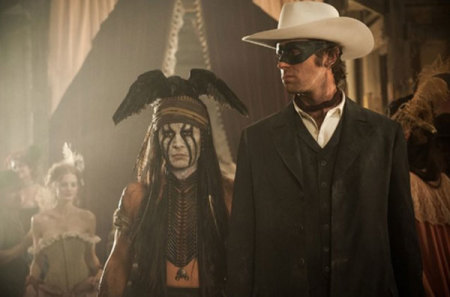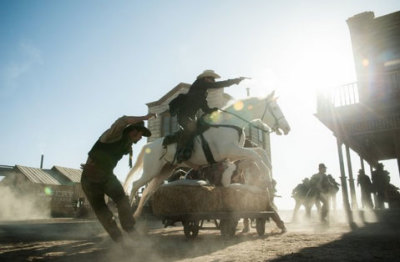'Lone Ranger' Film 'Pagan,' Betrayal of Hero's Character, Say Reviewers

Gore Verbinski's "Lone Ranger" opened in theaters Wednesday. Verbinski, director of the "Pirates of the Caribbean" franchise, brought along a familiar face, well-known actor Johnny Depp. Despite Depp's appeal, however, the film has received sour reviews, and two prominent reviewers explained why.
In an interview with The Christian Post, Dr. Ted Baehr, chairman of the Christian Film and Television Coalition and Editor-in-Chief of Movieguide, described the film's "strong mixed pagan, revisionist, politically correct worldview."
"The government is bad – the army is killing Indians – the bad guy is a businessman, the military-industrial complex is bad," he explained, finishing the list with a notable exception – "the Christians are not always bad."
Nevertheless, "the pagan elements triumph because you're looking at it from Tanto's point of view." He used "pagan" as a generic term for non-Christian, unidentified spirituality. "It's not Buddhism, it's not Hinduism, it's a mishmash."
"There's a lot of humor in the film, much at the expense of some of the Christians," he added, also mentioning the villain "who prays in the name of Jesus before he goes off slaughtering people."
But Baehr thinks that despite the film's flaw, he wouldn't go as far as saying the film is a "direct attack on Christians." "I don't think it's an evil film at all," he noted.
Tanto, the historical sidekick of the Lone Ranger, takes on a more central role in Johnny Depp in this version. "The filmmakers were trying to do something new with the story by making it tongue-and-cheek from the Native American's point of view, and instead of succeeding at that they ended up bringing out the worst in the story," said Baehr, who knows the director personally.
Other reviewers agreed, even arguing that despite Depp's move to include the Comanche Nation, the film only makes Native Americans look ridiculous.

But the paganism isn't the only reason "The Lone Ranger" got a beating in the press. "The images used for shock effect are creating a lot of the bad reviews out there," Baehr said, mentioning a graphic scene where a villain devours another man's heart.
"Overall, the movie is such a mess," Baehr concluded.
Baehr compared it to another recent film, "White House Down," which he alleged follows "the Southern Poverty Law Center playbook." The political thriller proved much more indoctrinating than the 'Lone Ranger,' but the filmmakers failed to tell the story."
"When the values are lost and everybody capitulates to evil, then you've got a problem," he concluded.
Paul Asay, senior associate editor for Focus on the Family's review blog, Plugged In, agreed with Baehr's criticism but hesitated to call the film "pagan." Noting the prominence of Tanto's perspective, he said, "you see a great deal more spiritism, animism, magic, and portent in everything he sees and does."
"Spiritism is not an unusual thing to see in movies these days – magical elements that don't exactly jive with Christianity," he argued. But when it came to Christianity, the "Lone Ranger" "felt a little bit mean."
"Most of the Christian characters are benevolently stupid or outright bad," Asay said.
He mentioned Presbyterians singing on the train, who prove "grating, silly, not really with it," a cavalry general who slaughters a village but "you definitely get the sense he's a religious guy," and the main villain, a train baron who prays publicly that the rangers – killed by his cronies – will return.
"That duplicitous prayer is the only nod that God may be working behind the scenes," Asay said. Since the Lone Ranger actually does come back, the baron's prayer is "sneakily answered." Besides that, the victory of good over evil is the only sign of a "kind and just and loving God working behind the scenes."
While the film never explicitly says Tanto's animism is true, "his view is more persuasive than the Christianity presented here."
"The carnivorous rabbits are fairly suggestive that the movie is pushing Tanto's view of the world," Asay added, throwing some humor in.
He argued the betrayal of the Lone Ranger tradition proved the film's most damning weakness. "I think that's the primary reason the movie doesn't work."
He noted that, in their original settings, neither the Lone Ranger nor Superman are characters that a modern American can identify with. "He is not meant to be a sort of flawed and frail character," Asay explained. "He is more of a template, an aspirational character."
"This is what goodness is like, the American character," he added. The Lone Ranger became the "embodiment of truth and justice in the rugged west."
"When you take away that aspirational heart of the Lone Ranger, you really are left with a guy in a mask," Asay argued. The original Lone Ranger "didn't wear a mask because he's becoming an outlaw," but for "a kind of modesty" – he didn't need praise.
The filmmakers "understood the legend behind the Lone Ranger, but I don't think they understood the character."
Despite his scathing criticism, Asay thoroughly enjoyed the final battle scene, which "really captured the sense of the Lone Ranger – it was charming, and loose, and fun." Those ten minutes "I wish I could show my family without having them slog through the other 140."
"It did not feel like a fun movie. It felt dark, it felt muddled, it felt confused about itself."
When asked about the release date, 150 years after the third day of the Battle of Gettysburg, Asay said "the mention [of Gettysburg] was intentional." "I can't speak to the timing of the movie's release, but definitely they were hearkening back to the bloodshed of Gettysburg." He added that the filmmakers likely intended it as a "popcorn movie" to fit the Fourth of July. Baehr denied any connection to Gettysburg.






















